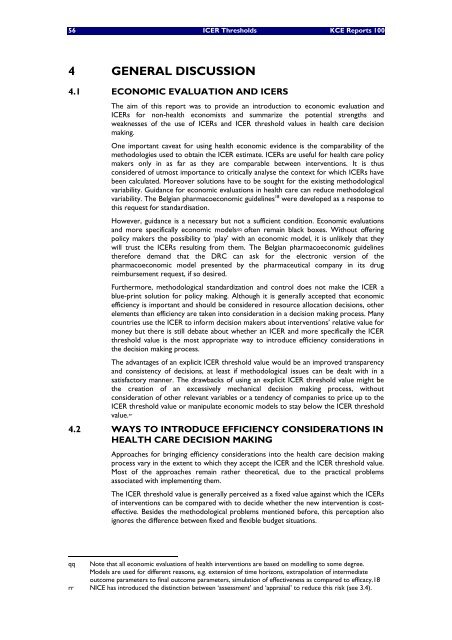Valeurs seuils pour le rapport coût-efficacité en soins de santé - KCE
Valeurs seuils pour le rapport coût-efficacité en soins de santé - KCE
Valeurs seuils pour le rapport coût-efficacité en soins de santé - KCE
You also want an ePaper? Increase the reach of your titles
YUMPU automatically turns print PDFs into web optimized ePapers that Google loves.
56 ICER Thresholds <strong>KCE</strong> Reports 100<br />
4 GENERAL DISCUSSION<br />
4.1 ECONOMIC EVALUATION AND ICERS<br />
The aim of this report was to provi<strong>de</strong> an introduction to economic evaluation and<br />
ICERs for non-health economists and summarize the pot<strong>en</strong>tial str<strong>en</strong>gths and<br />
weaknesses of the use of ICERs and ICER threshold values in health care <strong>de</strong>cision<br />
making.<br />
One important caveat for using health economic evid<strong>en</strong>ce is the comparability of the<br />
methodologies used to obtain the ICER estimate. ICERs are useful for health care policy<br />
makers only in as far as they are comparab<strong>le</strong> betwe<strong>en</strong> interv<strong>en</strong>tions. It is thus<br />
consi<strong>de</strong>red of utmost importance to critically analyse the context for which ICERs have<br />
be<strong>en</strong> calculated. Moreover solutions have to be sought for the existing methodological<br />
variability. Guidance for economic evaluations in health care can reduce methodological<br />
variability. The Belgian pharmacoeconomic gui<strong>de</strong>lines 18 were <strong>de</strong>veloped as a response to<br />
this request for standardisation.<br />
However, guidance is a necessary but not a suffici<strong>en</strong>t condition. Economic evaluations<br />
and more specifically economic mo<strong>de</strong>lsqq oft<strong>en</strong> remain black boxes. Without offering<br />
policy makers the possibility to ‘play’ with an economic mo<strong>de</strong>l, it is unlikely that they<br />
will trust the ICERs resulting from them. The Belgian pharmacoeconomic gui<strong>de</strong>lines<br />
therefore <strong>de</strong>mand that the DRC can ask for the e<strong>le</strong>ctronic version of the<br />
pharmacoeconomic mo<strong>de</strong>l pres<strong>en</strong>ted by the pharmaceutical company in its drug<br />
reimbursem<strong>en</strong>t request, if so <strong>de</strong>sired.<br />
Furthermore, methodological standardization and control does not make the ICER a<br />
blue-print solution for policy making. Although it is g<strong>en</strong>erally accepted that economic<br />
effici<strong>en</strong>cy is important and should be consi<strong>de</strong>red in resource allocation <strong>de</strong>cisions, other<br />
e<strong>le</strong>m<strong>en</strong>ts than effici<strong>en</strong>cy are tak<strong>en</strong> into consi<strong>de</strong>ration in a <strong>de</strong>cision making process. Many<br />
countries use the ICER to inform <strong>de</strong>cision makers about interv<strong>en</strong>tions’ relative value for<br />
money but there is still <strong>de</strong>bate about whether an ICER and more specifically the ICER<br />
threshold value is the most appropriate way to introduce effici<strong>en</strong>cy consi<strong>de</strong>rations in<br />
the <strong>de</strong>cision making process.<br />
The advantages of an explicit ICER threshold value would be an improved transpar<strong>en</strong>cy<br />
and consist<strong>en</strong>cy of <strong>de</strong>cisions, at <strong>le</strong>ast if methodological issues can be <strong>de</strong>alt with in a<br />
satisfactory manner. The drawbacks of using an explicit ICER threshold value might be<br />
the creation of an excessively mechanical <strong>de</strong>cision making process, without<br />
consi<strong>de</strong>ration of other re<strong>le</strong>vant variab<strong>le</strong>s or a t<strong>en</strong>d<strong>en</strong>cy of companies to price up to the<br />
ICER threshold value or manipulate economic mo<strong>de</strong>ls to stay below the ICER threshold<br />
value. rr<br />
4.2 WAYS TO INTRODUCE EFFICIENCY CONSIDERATIONS IN<br />
HEALTH CARE DECISION MAKING<br />
Approaches for bringing effici<strong>en</strong>cy consi<strong>de</strong>rations into the health care <strong>de</strong>cision making<br />
process vary in the ext<strong>en</strong>t to which they accept the ICER and the ICER threshold value.<br />
Most of the approaches remain rather theoretical, due to the practical prob<strong>le</strong>ms<br />
associated with imp<strong>le</strong>m<strong>en</strong>ting them.<br />
The ICER threshold value is g<strong>en</strong>erally perceived as a fixed value against which the ICERs<br />
of interv<strong>en</strong>tions can be compared with to <strong>de</strong>ci<strong>de</strong> whether the new interv<strong>en</strong>tion is costeffective.<br />
Besi<strong>de</strong>s the methodological prob<strong>le</strong>ms m<strong>en</strong>tioned before, this perception also<br />
ignores the differ<strong>en</strong>ce betwe<strong>en</strong> fixed and f<strong>le</strong>xib<strong>le</strong> budget situations.<br />
qq Note that all economic evaluations of health interv<strong>en</strong>tions are based on mo<strong>de</strong>lling to some <strong>de</strong>gree.<br />
Mo<strong>de</strong>ls are used for differ<strong>en</strong>t reasons, e.g. ext<strong>en</strong>sion of time horizons, extrapolation of intermediate<br />
outcome parameters to final outcome parameters, simulation of effectiv<strong>en</strong>ess as compared to efficacy.18<br />
rr NICE has introduced the distinction betwe<strong>en</strong> ‘assessm<strong>en</strong>t’ and ‘appraisal’ to reduce this risk (see 3.4).

















